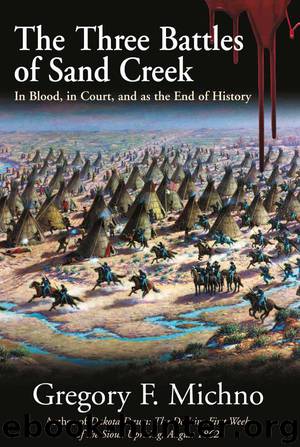The Three Battles of Sand Creek by Gregory Michno

Author:Gregory Michno
Language: eng
Format: epub
Publisher: Savas Beatie
Published: 2017-07-22T16:00:00+00:00
Chapter 10
Scalp Dance
When the main action was over, some of the ghoulish deeds that made the “battle” at Sand Creek infamous occurred. Stories circulated among the Indians and soldiers of instances where fingers, ears, hearts, and genitals were mutilated or cut out—from both men and women. White Antelope had been maimed. Jim Beckwourth, no friend of Colonel Chivington, claimed that Indians were scalped, but “White Antelope was the only one I saw that was otherwise mutilated.” The Indians argued that the vengeance was worse than was done by the Pawnees, the bittere enemies of the Cheyenne. John Smith claimed to seen Indian bodies “worse mutilated than I ever saw before.” They were cut “with knives; scalped; their brains knocked out.”1
Major Anthony recalled several scalped Indians, but did not see any additional mutilations. Bodies with “their privates cut off and all that kind of thing—I never saw anything of that, and I never heard it until I saw it in those affidavits at Fort Lyon, two months after the fight.” Anthony did see a child walking in the sand trying to catch up to those who had abandoned him. “I saw one man get off his horse, at a distance of about seventy-five yards, and draw up his rifle and fire—he missed the child. Another man came up and said, ‘Let me try the son of a bitch; I can hit him.’ He got down off his horse, kneeled down and fired at the little child, but missed him. A third man came up and made a similar remark, and fired, and the little fellow dropped.” Anthony also saw one mortally wounded Indian woman escaping with two children. When she could run no farther, she “gathered her two children near her, and cut both of their throats,” testified Anthony. “That was not done by our men.”2
Lieutenant Cramer verified these incidents. He wrote to Major Wynkoop that “squaws were known to kill their own children, and then themselves, rather than to have them taken prisoner.” Captain Soule said much the same thing, although the fact that he hid out for most of the battle makes it likely that he was repeating only what he had heard. According to Soule, one woman “took a knife and cut the throats of both children, and then killed herself. One old squaw hung herself in the lodges.” Red Dust Woman told of Arapaho women who were with the soldiers and aided in some of the mutilations, while one took an Arapaho child off one of the wagons two days after the fight and left it by the roadside to die.3
Soldiers committed atrocities, but a disposition to commit murder and mayhem was not a characteristic unique to any one people. Robert McFarland was abandoned on the prairie when Coffin’s detachment fled without him. When his body was found, a squad under Sgt. William M. Barney returned with it. McFarland’s scalp could not be taken because his hair was so short that he was virtually bald, but his chest had been chopped open, and his splintered gun shoved into the open wound.
Download
This site does not store any files on its server. We only index and link to content provided by other sites. Please contact the content providers to delete copyright contents if any and email us, we'll remove relevant links or contents immediately.
| Africa | Americas |
| Arctic & Antarctica | Asia |
| Australia & Oceania | Europe |
| Middle East | Russia |
| United States | World |
| Ancient Civilizations | Military |
| Historical Study & Educational Resources |
Cat's cradle by Kurt Vonnegut(14785)
Pimp by Iceberg Slim(13809)
Underground: A Human History of the Worlds Beneath Our Feet by Will Hunt(11850)
4 3 2 1: A Novel by Paul Auster(11823)
The Radium Girls by Kate Moore(11642)
Wiseguy by Nicholas Pileggi(5336)
American History Stories, Volume III (Yesterday's Classics) by Pratt Mara L(5141)
Perfect Rhythm by Jae(5084)
The Fire Next Time by James Baldwin(5034)
Paper Towns by Green John(4815)
Pale Blue Dot by Carl Sagan(4633)
A Higher Loyalty: Truth, Lies, and Leadership by James Comey(4568)
The Mayflower and the Pilgrims' New World by Nathaniel Philbrick(4288)
The Doomsday Machine by Daniel Ellsberg(4254)
Killers of the Flower Moon: The Osage Murders and the Birth of the FBI by David Grann(4199)
Too Much and Not the Mood by Durga Chew-Bose(4105)
The Sympathizer by Viet Thanh Nguyen(4100)
The Borden Murders by Sarah Miller(4033)
Sticky Fingers by Joe Hagan(3918)
